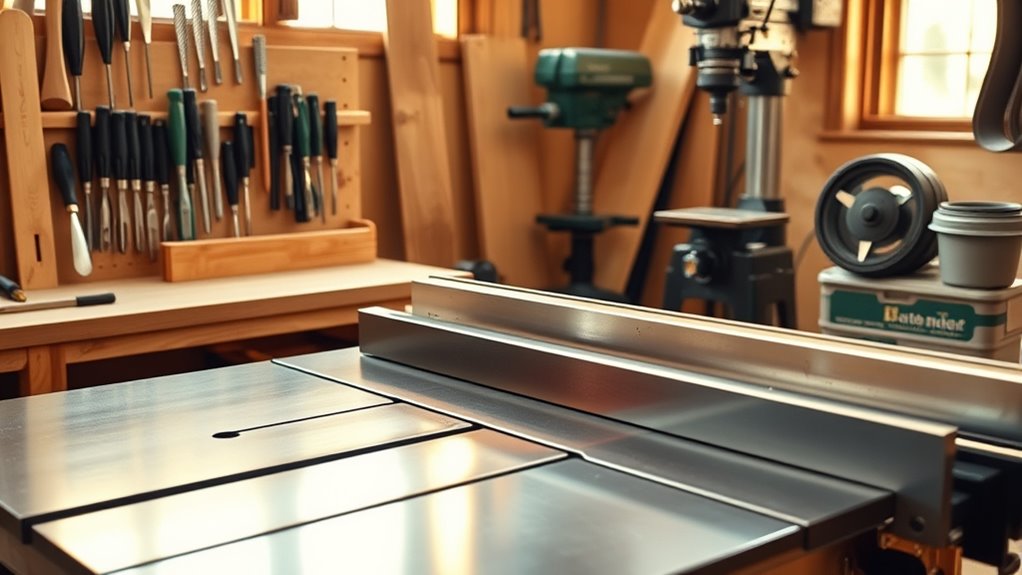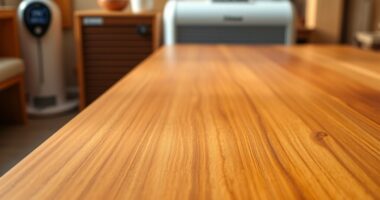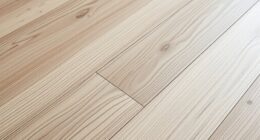To maintain your woodworking equipment, start with regular safety inspections, checking controls, safety features, and wiring. Keep your machines clean by removing dust and debris with compressed air and brushes, and make certain dust collection systems work well. Lubricate moving parts regularly using approved lubricants, and monitor tools for wear using visual checks and sensor data. Scheduling preventative maintenance based on usage helps prevent breakdowns and extends tool life. Continue exploring for more tips to keep your tools safe and efficient.
Key Takeaways
- Conduct regular safety inspections, check controls, safety features, and ensure proper calibration to prevent accidents.
- Clean dust, debris, and filters regularly using compressed air, brushes, and vacuums to maintain equipment efficiency.
- Lubricate moving parts with manufacturer-recommended lubricants, and follow scheduled preventative maintenance routines.
- Monitor tool wear through visual inspections and sensor data analysis to schedule timely replacements and avoid failures.
- Incorporate predictive maintenance, document procedures, and educate operators to extend equipment lifespan and optimize productivity.
Conducting Regular Safety Inspections and Ensuring Guard Integrity

Regular safety inspections are essential to keep woodworking equipment operating safely. Before each use, you should inspect machines to confirm operational controls, safety features, power drives, and cutting edges are in good condition. Using an airless paint sprayer that is properly maintained ensures optimal performance and safety during operation. Make certain machines are constructed to minimize vibration when the largest tool is mounted and running at full speed. Check that arbors and mandrels have secure bearings and no play, which is crucial for safe operation. Your inspections must comply with OSHA standards under 29 CFR 1910.213 and 29 CFR 1926.304, and you should document all findings, noting issues and actions taken. Regularly reviewing these inspections helps you identify hazards early, maintain compliance, and ensure your equipment functions safely, reducing the risk of accidents or injuries in your workspace. Incorporating safety standards into your inspection routine further enhances workplace safety and helps prevent potential hazards. Additionally, staying informed about technological advancements can help you adopt new safety measures and improve your inspection process. Engaging in ongoing training and education ensures you remain current with industry best practices and safety protocols. Conducting periodic equipment calibration can further ensure precision and safety in your woodworking operations.
Implementing Effective Cleaning and Dust Management Practices
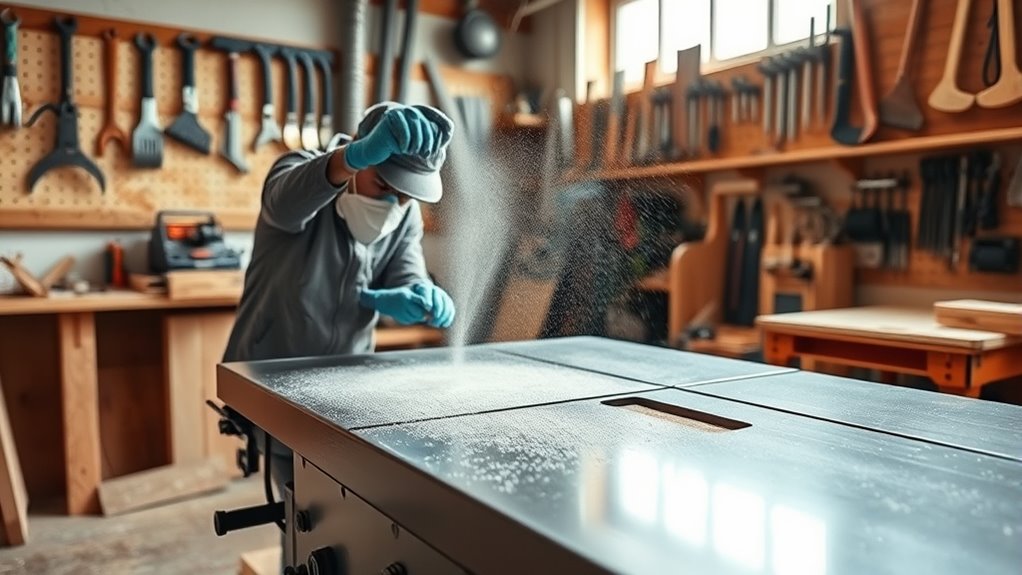
Implementing effective cleaning and dust management practices is essential for maintaining safe and efficient woodworking equipment. Use compressed air to blow out microscopic dust and debris from hard-to-reach parts, preventing buildup that can impair function. Employ tiny brushes to loosen dust on surfaces and slats without causing damage. Regularly wipe surfaces with shop towels to remove oils and dust before they accumulate. Use a vacuum with crevice attachments to clear sawdust from machine crevices and gears. Remove removable parts like throat plates and guards for thorough cleaning. Apply specialized cleaning solutions, such as emulsions that dissolve resin and burnt dust, avoiding harsh chemicals. Maintain an efficient dust collection system and clean filters regularly. Keep floors clean and use air filtration units to improve air quality and reduce dust hazards. Incorporating digital literacy programs can also help users better understand and manage their equipment’s maintenance needs. Staying informed about resources and tools available for equipment maintenance can further enhance your safety and efficiency. Understanding industry standards can also guide proper maintenance routines and ensure compliance with safety regulations.
Performing Routine Lubrication and Maintenance of Moving Parts

Performing routine lubrication and maintenance of moving parts is essential to keep your woodworking equipment operating smoothly and safely. Begin by unplugging your machines, then carefully clean gears, shafts, pivots, and worm gears using solvents like paint thinner to remove old grease, dirt, and sawdust buildup. Regularly monitoring your equipment’s payment data protection can help prevent theft and ensure the integrity of your workshop’s assets. Select lubricants specifically designed for woodworking machinery; dry lubes like 3-in-One dry lube or synthetic greases such as Mobil 1 offer durable, dust-resistant protection. Apply lubricants to high-friction points like hinges, pivots, and bearings, then move parts through their full range to ensure even distribution. Avoid over-lubricating, as excess can attract dust and grime. Proper lubrication practices can also reduce equipment downtime, keeping your workflow efficient and minimizing costly repairs. Incorporating air purifier features such as HEPA filters and UV light technology can improve air quality in your workshop, preventing dust accumulation and maintaining a healthier environment. Additionally, using air purifiers with high CADR ratings can significantly enhance dust removal efficiency. Implementing a preventive maintenance schedule ensures that potential issues are addressed early, extending the lifespan of your equipment. Establish a regular schedule—quarterly or as needed—to prevent wear, reduce heat, and prolong your equipment’s lifespan.
Monitoring Tool Wear and Scheduling Replacement Procedures
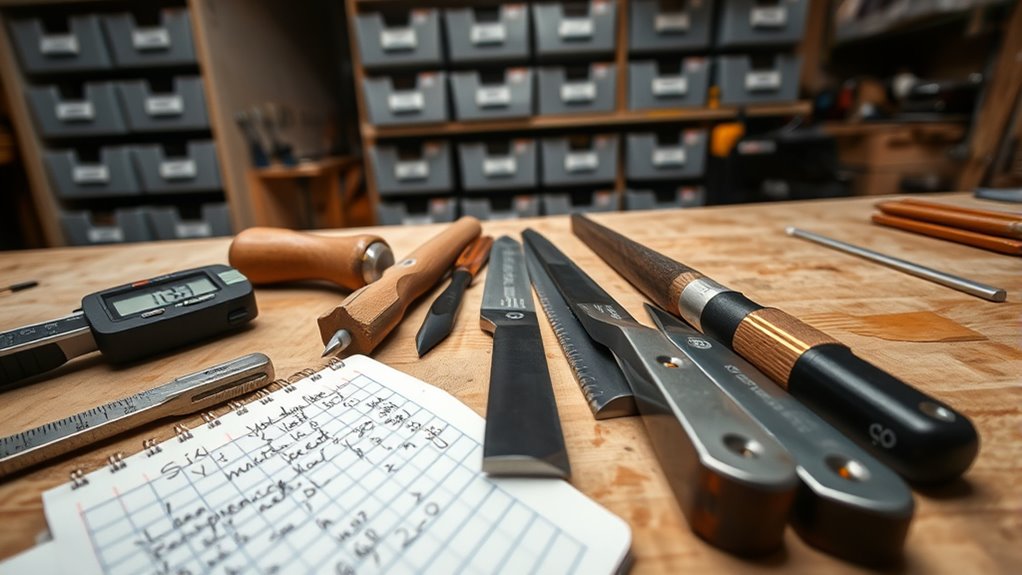
Monitoring tool wear is crucial for maintaining peak woodworking equipment performance and preventing unexpected failures. You can use both offline direct methods, like visual inspections, and online indirect methods, such as analyzing signals during operation. Incorporating data-driven strategies can further improve the accuracy of wear assessments by leveraging accumulated sensor data over time. Indirect techniques involve collecting data from cutting force, vibration, and electrical current sensors, which reflect the tool’s condition. To get accurate results from noisy signals, signal processing techniques like wavelet analysis, EMD, and VMD are essential. Machine learning algorithms enhance wear detection by analyzing these signals without direct measurement, offering reliable, real-time assessments. Setting wear thresholds based on these analyses allows you to schedule replacements proactively, avoiding costly failures. Continuous monitoring helps optimize tool life and minimizes downtime, ensuring your woodworking processes stay efficient and high quality.
Planning and Executing Preventative Maintenance Schedules

Planning and executing effective preventative maintenance schedules start with establishing maintenance frequencies that match your equipment’s usage patterns. Machines used daily for long hours need more frequent upkeep than those used sporadically.
For example, an edgebander operated eight hours daily might require biannual maintenance, while infrequent-use tools need less often. Higher usage increases wear, so your schedule must reflect abuse levels to prolong equipment life and ensure performance. Incorporating preventative maintenance best practices can further optimize your schedule and extend equipment lifespan. Regularly reviewing maintenance records helps identify recurring issues and adjust schedules accordingly.
Assign clear responsibilities to operators or technicians, and track tasks through digital systems or sign-off sheets. Regular inspections, lubrication, and part replacements help prevent breakdowns and minimize downtime. Additionally, monitoring equipment condition can help identify issues before they lead to costly repairs. Implementing predictive maintenance techniques can also help forecast potential failures and schedule repairs proactively. Align maintenance activities with slower production periods to reduce disruptions. Consistent, well-planned schedules keep your woodworking equipment running smoothly and extend their operational lifespan.
Frequently Asked Questions
How Often Should I Replace Safety Guards on My Equipment?
You might wonder how often you should replace safety guards. It depends on their condition and wear. You should replace guards immediately if you notice damage, cracks, or deformation.
Inspect them daily for misalignment or wear, and do thorough monthly checks. Replace any that no longer fit securely or are incompatible with updated machinery.
Following OEM recommendations and OSHA standards helps guarantee your guards stay effective and compliant, keeping everyone safe.
What Signs Indicate Dust Buildup Is Affecting Machine Performance?
Imagine your machine as a runner slowing down due to a heavy backpack—that’s dust buildup. You’ll notice sluggish operation, overheating, or erratic behavior.
Dust in filters or ducts causes pressure drops, and vibration or strange noises signal trouble. If you see excess fine dust, inconsistent finishes, or frequent tool jams, dust is likely affecting performance.
Regularly check these signs to keep your equipment running smoothly and prevent costly breakdowns.
How Can I Identify Early Wear in Cutting Tools?
To identify early wear in your cutting tools, look for visual signs like chipping, flank wear, or built-up edges. Use a magnifier or microscope to spot tiny cracks or coating damage.
Also, listen for changes in noise, feel increased vibration or cutting force, and check the surface finish for roughness or tearing.
Monitoring tool performance regularly helps catch wear early, preventing costly damage and ensuring smooth operation.
What Are Best Practices for Disposing of Used Lubricants?
You might think disposal is complicated, but it’s straightforward when you follow best practices. Keep used lubricants in clearly labeled, dedicated containers, and store them separately from fresh oils.
Never pour waste oil down drains or into the environment. Use licensed waste carriers and recycling facilities whenever possible.
Regularly check containers for leaks, and retain proof of proper disposal. This keeps you compliant, safe, and environmentally responsible.
How Do I Safely Test Machinery After Maintenance?
When testing machinery after maintenance, you should start by turning off the power. Then perform safety checks like inspecting guards and tools.
Wear PPE and guarantee the area is well-ventilated.
Gradually power up the machine, observing for unusual noises, vibrations, or overheating.
Monitor performance carefully, and if everything runs smoothly, proceed with load testing.
Always document the process and clean the equipment afterward for safe, effective operation.
Conclusion
By staying vigilant with safety checks, cleaning, and maintenance, you’re the captain steering your woodworking ship through calm and storm. Regular inspections and care keep your tools sharp and reliable, preventing unexpected breakdowns that can sink your progress. Think of your equipment as a finely tuned orchestra—when each part is maintained, everything plays in harmony. Keep up with your upkeep, and your woodworking journey will be smooth sailing, creating masterpieces with confidence and ease.
